Nestled between Scotland and England, the Solway Moss is more than just a stretch of boggy terrain—it’s a land steeped in history, conflict, and mystery. This seemingly unassuming peat moss, located near the border town of Gretna Green, has witnessed centuries of human activity, serving as a backdrop for some of the most intriguing chapters in British history. Let’s delve into the history and mysteries of the Solway Moss and explore why this bog has captivated the imaginations of historians and storytellers alike.
The Debateable Land: A Region of Conflict
The Solway Moss is part of what was historically known as the "Debateable Land," a region of contested territory between England and Scotland. This area, stretching between the rivers Sark and Esk, was a source of ongoing disputes and bloody skirmishes between the two nations. Despite its strategic significance, the Debateable Land was hardly a paradise. Much of it was composed of bogs, marshes, and quagmires—difficult and treacherous to traverse.
During the medieval period, this land became a haven for outlaws, raiders, and those looking to escape the law. The harsh and unforgiving landscape of the Solway Moss made it an ideal place for such individuals, as few would dare to pursue them into the treacherous bogs. The moss itself was notorious for its ability to swallow up those who ventured too far off the beaten path, adding to its reputation as a place of danger and mystery.
The Roman Legacy: Walls and Fortifications
The history of the Solway Moss is intertwined with the story of Roman Britain. During the Roman occupation, this area marked the northern frontier of the empire. To protect their territory from the fierce northern tribes—the Picts and Caledonians—the Romans constructed a series of defensive walls across the island. Notably, the walls of Agricola, Adrian, and Severus, mentioned in ancient texts, ran through or near this region.
The wall of Severus, built around 208 AD, was a massive fortification stretching across the island from the Solway Firth to the River Tyne. This wall, made of stone and grouted with lime, was designed to keep out the northern tribes. It was heavily fortified, with watchtowers and garrisons stationed along its length. However, the Solway Moss and the surrounding area proved challenging even for the Romans. The loamy, unstable soil made construction difficult, and over time, much of the wall has eroded, reclaimed by the earth from which it was built.
Today, remnants of these Roman fortifications can still be found, although much of the original structure has been lost to time. The Solway Moss itself, however, remains a testament to the difficulties the Romans faced in taming this wild and untamed frontier.
The Battle of Solway Moss: A Turning Point in History
One of the most significant events associated with the Solway Moss is the Battle of Solway Moss, which took place on November 24, 1542. This battle was a decisive moment in the conflict between England and Scotland. The Scots, led by James V, launched an ill-fated invasion of England, only to be met with a crushing defeat by the English forces.
The terrain of the Solway Moss played a crucial role in the outcome of the battle. The boggy ground made it difficult for the Scottish forces to maneuver, and many soldiers became trapped in the mire. The English took advantage of the Scots' disarray, leading to a humiliating defeat for James V. The loss at Solway Moss had far-reaching consequences, leading to the eventual downfall of the Scottish king and setting the stage for the union of the crowns under James VI of Scotland and I of England.
The Mysteries of the Moss
While the Solway Moss is rich in history, it is also a place of enduring mystery. The bogs have long been rumored to hold the remains of those who perished in the battles and skirmishes fought in the area. Local legends speak of lost treasure buried in the moss, hidden by fleeing soldiers or raiders. Over the centuries, the moss has swallowed up not only the dead but also countless artifacts, which remain hidden beneath its surface.
The bog itself is a natural wonder. Composed of peat—a dense, waterlogged material formed from decaying plant matter—the Solway Moss has a unique ability to preserve organic materials. This has led to the discovery of well-preserved bodies, known as "bog bodies," in similar peat bogs across Europe. These bodies, often thousands of years old, provide valuable insights into ancient peoples' lives and deaths. While no such discoveries have yet been made in the Solway Moss, the possibility remains an intriguing one for archaeologists and historians alike.
A Legacy of Conflict and Resilience
The Solway Moss, and the broader Debateable Land, represents a unique intersection of history, nature, and legend. From its role in Roman Britain as a frontier defense to its place in the conflicts between England and Scotland, this boggy terrain has been both a barrier and a battleground. Today, it stands as a reminder of the challenges faced by those who lived and fought in this region and the enduring mysteries that still lie beneath its surface.
As we walk along the Solway Moss, we tread on ground that has witnessed the passage of armies, the rise and fall of kings, and the stories of countless individuals who have left their mark on history. It is a place where the past and present converge, and where the mysteries of the past continue to beckon to those who are willing to explore its depths.





